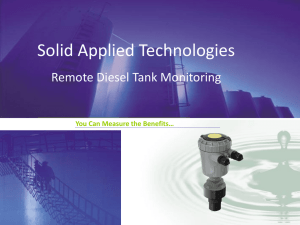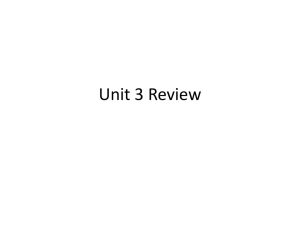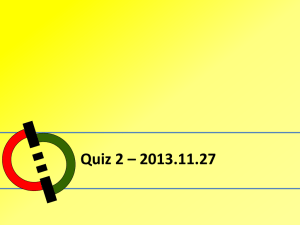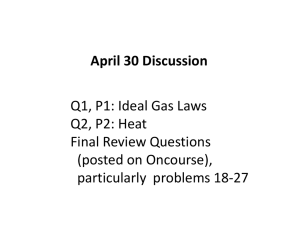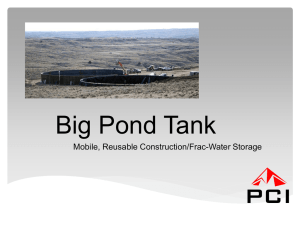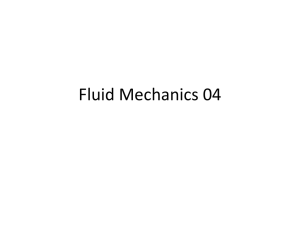1 st Natural Mode Shape
advertisement
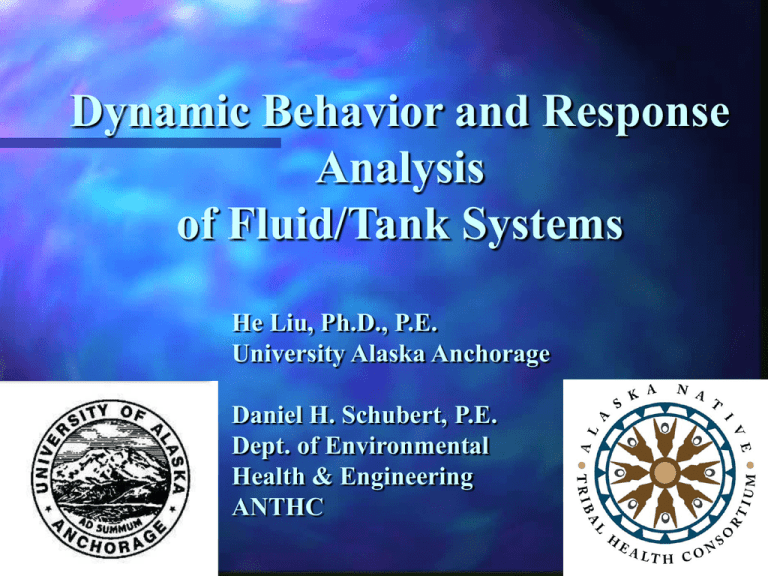
Dynamic Behavior and Response Analysis of Fluid/Tank Systems He Liu, Ph.D., P.E. University Alaska Anchorage Daniel H. Schubert, P.E. Dept. of Environmental Health & Engineering ANTHC 1 Tanks Rupture: A water tank was lifted off a gravel base six to ten inches during an earthquake. After the earthquake, the tank was resting on the gravel base about212 inches lower (due to buckle) and shifted about an inch to the west. 3 Courtesy U.C. Berkley 4 Courtesy U.C. Berkley 5 Courtesy U.C. Berkley 6 Courtesy U.C. Berkley Tank seismic Design Code is mainly based on simplified Rigid Tank assumption, and NO fluid/structure interaction included Theoretical solutions are available only for rigid tanks and no interaction An approximate “Cantilever Beam” approach needs numerical proof. 7 The Approximate “Cantilever-Beam” Approach For approximate frequencies can be calculated by equation f’0 is the natural frequency of the fluid tank system with roof mass fo is the natural frequency without the roof fFB and fSB is the natural frequency of an empty tank with the mass of the roof 8 Purposes of This Study Use the Finite Element Analysis (FEA) To evaluate the performance of steel water tanks due to earthquake excitation To compare results with Design Code of AWWA’s simplified formula’s To verify the approximate “Cantilever-Beam” approach. 9 z water level Ht H x tb y r Radius =16 feet Height = 26 feet x R Water Depth = 24 feet =0o ts Wall Thickness =0.315in Tank Geometry 10 Modeling Approach I -Tank Tank wall/roof/base - shell and beam elements Fluid - Fluid 3-D Contained Fluid Element Material Properties - Steel E = 29,000 ksi - Steel density = 7.34x104 lb-sec2/in4 - Fluid density = 0.9345x104 lb-sec2/in4 - Fluid bulk modulus = 30x104 lb/in211 Modeling Approach II 3-D Contained Fluid Elements 8 nodes - 3 DOF Free surface - added spring Bulk modulus = 30 x 104 lb/in2 Fluid elements do not attached at tank wall and base Coincident nodes coupled normal to the interface to allow fluid relative movement in tangential and vertical directions 12 Free horizontal movement at base Modeling Approach III - Meshing FEA Models Because of the system symmetry, one half of the tank is modeled. Fluid elements are rectangular-brick shaped whenever possible Number of Fluid Elements in ANSYS Model: - 640, 1280, 2112, 3072 - Based on accuracy and efficiency, 1280 fluid elements was chosen 13 partially filled with a near incompressible water water-contained fluid elements tank--shell and beam elements interaction between water and tank wall is included 14 How to verify the numerical solution from ANSYS FEA models? 15 ANSYS Rigid Tanks ANSYS Theory Rigid Tanks Yes Approximate Flexible Tanks Flexible Tanks Comparison & Conclusion AWWA Simplified “Rigid” Tank Method ANSYS Unanchored 16 1st Natural Mode Shape – Water Sloshing One-Cosine Type Sloshing Mode 17 2nd Natural Mode Shape – Water Sloshing Two-Cosine Type Sloshing Mode 18 3rd Natural Mode Shape – Water Sloshing Three-Cosine Type Sloshing Mode 19 4th Natural Mode Shape – Water Sloshing Four-Cosine Type Sloshing Mode 20 Modal Analysis Results: Comparison of Convective Frequencies No. of Fluid Elements in ANSYS Model 640 1280 2112 3072 Theory (Units: Hz) 1st mode 0.299 0.298 0.298 0.298 0.305 2nd mode 0.477 0.476 0.475 0.474 0.521 3rd mode 0.562 0.555 0.660 0.552 0.551 Note: Compared with results of linear theory, the first mode differs by 1.7%. Differences may be related to limitations on the linear theory, with nonlinear theory closer to FEA values.21 For Rigid Tanks ANSYS Results Modeling approach is acceptable Theoretical Results Flexible Tank Analysis 22 Modal Analysis for Flexible Tanks A total of 54 geometric variations, with and without roofs, were analyzed. Tank/fluid variables were represented by three basic parameters: Tank geometric aspect ratios, as represented by the tank height to radius (H/R) Tank shell wall thickness ratio represented by the wall thickness to tank radius (ts/R) Liquid depth ratio (h/R) 23 1st Natural Mode Shape – Full Tank 24 2nd Natural Mode Shape – Full Tank 25 3rd Natural Mode Shape – Full Tank 26 1st Natural Mode Shape - Partially Full Tank 27 2nd Natural Mode Shape – Partially Full Tank 28 3rd Natural Mode Shape – Partially Full Tank 29 1st Natural Mode Shape – Tall-Full Tank 30 1st Natural Mode Shape – Short-Full Tank 31 1st Natural Mode Shape – Tall-Partial-Full Tank 32 2nd Natural Mode Shape – Tall-Partial-Full Tank 33 Modal Frequency Comparison 1st Natural Frequency (H/R=0.667) Frequency(Hz) 14 12 10 8 6 4 2 0 0 t/R=.0005 Theory 0.2 h/R 0.4 t/R=.001 Theory 0.6 0.8 t/R=.00139 Theory 34 Modal Frequency Comparison 1st Natural Frequency (H/R=1.5) 30 Frequency(Hz) 25 20 15 10 5 0 0 0.5 t/R=.001 Theory h/R 1 t/R=.002 Theory 1.5 t/R=.0025 Theory 35 Modal Frequency Comparison Frequency(Hz) 1st Natural Frequency (H/R=3) 20 15 10 5 0 0 t/R=.001 Theory 1 h/R t/R=.002 Theory 2 3 t/R=.0035 Theory 36 Modal Frequency Comparison 2nd Natural Frequency (H/R=0.667) Frequency(Hz) 20 15 10 5 0 0 t/R=.0005 Theory 0.2 h/R 0.4 t/R=.001 Theory 0.6 0.8 t/R=.00139 Theory 37 Modal Frequency Comparison Frequency(Hz) 2nd Natural Frequency (H/R=1.5) 50 40 30 20 10 0 0 t/R=.001 Theory 0.5 h/R t/R=.002 Theory 1 1.5 t/R=.0025 Theory 38 Modal Frequency Comparison 2nd Natural Frequency (H/R=3) Frequency(Hz) 25 20 15 10 5 0 0 t/R=.001 Theory 1 h/R t/R=.002 Theory 2 3 t/R=.0035 Theory 39 For Flexible Tanks Approximate “Cantilever-Beam” Results Acceptable ANSYS Results 40 (ANSYS Results) 41 Earthquake Ground Input: El Centro N-S Adjusted 0.4g Acceleration Acceleration, g 0.4 max = 0.4 g 0.2 0 -0.2 -0.4 Velocity Velocity, in/sec 0 Displacement, in Displacement 4 6 30 20 10 8 10 max = 21.3 in/sec 0 -10 -20 -30 0 2 2 4 6 10 8 10 max.= 14.5 in 0 -10 -20 0 2 4 6 Time, seconds 8 10 42 Pressure Time History (3 ft. from Base) Pressure, (ksi) 0.016 0.012 0.008 0.004 0 0 1 2 3 4 5 Time (seconds) 6 7 8 43 0.000 0.005 0.010 0.015 Depth of Fluid (ft) -4 Pressure distribution along wall at = 0o and T=3.21 Sec. -9 -14 -19 -24 Pressure (ksi) 44 Depth of fluid, ft. 20 Compare with Rigid Tank solutions: 15 Pressure distribution along wall at = 0o 10 5 0 0 0.005 0.01 Pressure, ksi 0.015 45 46 Courtesy U.C. Berkley Stress Time History Results Hoop and Axial Stress Z=-21 ft at = 0o Hoop and Axial Stress Z=-21 ft at = 180o 10 5 0 -5 0 2 4 Time (sec) Hoop Right Stress (ksi) Stress (ksi) 15 6 8 Axial Right 12 10 8 6 4 2 0 -2 -4 0 2 Hoop Left 4 Time (sec) 6 Axial Right 47 8 Water Surface Displacement Time History Displacement (inch) 40 20 =180o 0 -20 0 5 =0o Left side Right side -40 Time (seconds) 48 Water Surface Profile at Time=5.09sec. Displacement, (inch) (Maximum Water Surface Displacement = 33 inches) 40 20 0 0 6 12 18 24 30 -20 -40 Distance, (ft) 49 50 von Mises Stress Distribution at T=4.63 sec. 51 52 Courtesy U.C. Berkley Base Shear Time History Results 0.013 Pressure (ksi) 0.012 0.011 0.01 0.009 0.008 0.007 0.006 0 1 2 3 4 Time (second) 5 6 7 8 53 Overturning Moment Time History 0.013 Pressure (ksi) 0.012 0.011 0.01 0.009 0.008 0.007 0.006 0 1 2 3 4 Time (second) 5 6 7 8 54 Comparison of ANSYS Results with that from AWWA D100 Method Base Shear (kips) Comparison (%) FEA ANSYS 620 100 Approximate Approach 591 95.3 Simplified in AWWA 487 78.6 55 Spectrum Analysis Comparison Spectral A cceleration (g's) 90 H /R=.67, h/R=.6, t/R=.001 1.2 80 70 1 600.8 East West North 500.6 400.4 30 0.2 20 0 10 0.001 0 0.01 0.1 1 Period (sec) Spectrum W ith Roof 1st Qtr Design 2nd Qtr 3rd Qtr 4thCode Qtr Theoretical Design 56 Conclusions FEA method allows for a more complete evaluation of seismic loading conditions on fluid/tank systems. Rigid tank assumptions provide un-conservative solutions. “Cantilever-beam” approach provide very good approximations for design purpose. Further refinements in standard design procedures should permit performance 57 based designs. 58


